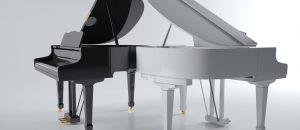What follows is an article which appears on the Yamaha corporate website. This article, written by Yamaha’s service manager, details the company’s position with respect to the purchase of used Japanese-made instruments. Following each of the six major points presented in the article we have responded with additional information which we believe is essential to making an informed decision on this issue.
What About Purchasing A Used Yamaha Piano?
Customers frequently call Yamaha Piano Service to ask about purchasing a used Yamaha piano. Typically, they want to know how old the piano is, whether it is a good piano or not, how much the piano is worth and if they should purchase it or not. We do our best to answer their questions, from a technical standpoint.
We first remind the customer that they are asking us about a used piano. We explain that there is always some degree of risk involved in purchasing any used product. Without a thorough inspection by a qualified technician, it is impossible to know whether the piano has been properly maintained, whether or not it is damaged, how worn out the piano is, or whether the piano is in need of major rebuilding.
We recommend that they contact a competent piano technician and have the technician make a thorough inspection of the piano, before purchasing it.
Vienna Piano Co. is owned by a piano technician. We rebuild and recondition pianos for a wide variety of clients. We thoroughly inspect every instrument we handle; this is why we warranty all parts and labor for ten years on every piano we offer. Some people also choose to have an independent technician inspect the piano for them. We encourage this if it makes the person more comfortable with their decision.
What Potential Used Piano Buyers Should Be Aware Of
Fortunately, we have detailed warranty records on the pianos Yamaha Corporation of America has sold in the United States. We can quickly determine the date the piano was sold to the dealer, the date the dealer sold the piano, along with the warranty history of the piano. With this information, along with the experience we have had providing warranty support for several hundred thousand Yamaha pianos in the U.S. during the last 35 years, we can provide information that may assist in reducing the purchase risk for the potential customer.
More and more frequently, however, the used pianos customers are asking about were not originally sold in the USA. More often than not, it is a well-used older piano that was recently brought in from Japan and sold to a piano dealer in the USA. When asked about one of these pianos we cannot provide information about the piano, other than that it was not made for this market.
Whats The Main Issue With Used Yamaha Pianos Made For The Japanese Market?
Yamaha had manufactured pianos for Japan and the Asian market for over 50 years before exporting pianos to North America and Europe. In the 1960s, Yamaha began exporting pianos to the United States and Canada. Our engineers were unaware of the level of dryness that existed in North American homes.
Consequently, some of the Yamaha pianos sold in North America during the 1960s developed dryness-related problems. Upon researching these problems, our engineers found that in general, the indoor environments of homes in North America are considerably drier than in Japan. Some of this is related to the outdoor climate and some of it is related to the indoor environment, which is affected by such conditions as air conditioning and heating systems.
This is true. Yamaha pianos built in the early 1960’s developed dryness-related problems in the dry southwest, so much so that Yamaha had to repair and replace most of the pianos in this region.
This is only half true because it fails to mention that not only pianos destined for North America but all Yamahas, including those destined for the Japanese market were produced properly seasoned for the American home. Computer-controlled drying kilns as as well as other manufacturing procedures were used on all instruments produced in the Yamaha factory.
This is simply not true. When the new equipment and manufacturing techniques were employed, it was a factory-wide changeover. This was the only way to achieve economies of scale, maintain efficiency and keep costs down in order to compete in the world market. At this time Yamaha began drying their pianos – all of their pianos – to the standard of European and US manufacturers.
After 1966 none of the dryness-related problems occurred in the states again. And none of these problems occured in pianos that were sold to the Japanese domestic market after 1966 because the pianos were from the same factory, the same assembly line, and the same kiln-dried materials.
So What Does Yamaha Corporation Of America Recommend?
Will one of these pianos develop severe problems after several years in the U.S.? Unless the piano is placed in a very humid environment (similar to Japan), the piano may develop problems that will be expensive to correct.
We know this because of the numerous calls we receive from customers and piano technicians reporting dryness-related problems with these used pianos brought in from Japan. We do not experience these types of problems with pianos that are seasoned for the North American markets.
This is obviously not true. Tokyo is at the same latitude as Philadelphia with almost the same average relative humidity. Japan spans latitudes from Concord, New Hampshire to Key West, Florida. Winters in parts of Japan are the same as in the northwestern U.S., with home heating systems drying the air to levels between 10% and 20%. Not all of Japan is a humid enviornment, but this article leads the reader to believe that.
What is true is that Japan does not have the radical arid climate of the American southwest and in the early 1960s Yamaha didn’t engineer their instruments for this type of constant dryness. Even if they had not corrected it, this would not be an issue for the rest of North America. They did correct it, however, and the change was a welcome improvement.
It is common knowledge in the technical community that even pianos manufactured in the U.S., for the North American climate have dryness-related problems in our most arid regions.
This final paragraph is not only an outright lie, but it is also a lie that appeals to a common fear that most people have of purchasing anything with mechanical parts.
By 1920 the piano industry reached its state of the art and standardized its parts. Today’s models, including Yamaha, are basically replicas of turn of the century designs. Manufacturing techniques have changed but the actual parts have not.
It is Yamaha corporate policy that they will not sell parts to any piano which was originally sold in the domestic Japanese market. As a result, part replacement in the most cases is impossible from Yamaha, because Yamaha refuses to supply parts.
The truth is that there are numerous other suppliers of replacement parts for Yamaha parts and all other piano parts. In fact, many parts of bothYamaha pianos and many other piano makers are manufactured by specialized component parts makers. This happens in a wide variety of industries such as the automotive and electronics industries.
– Bill Brandom
Yamaha Piano Service Manager
What is most disturbing about this article is that it was written by Yamahas Piano Service Manager. This is the person who should be giving truthful and accurate product information to the technical community and the public. Instead, he is telling half-truths and appealing to the emotion of fear in order to dissuade people from purchasing a used Yamaha piano.


